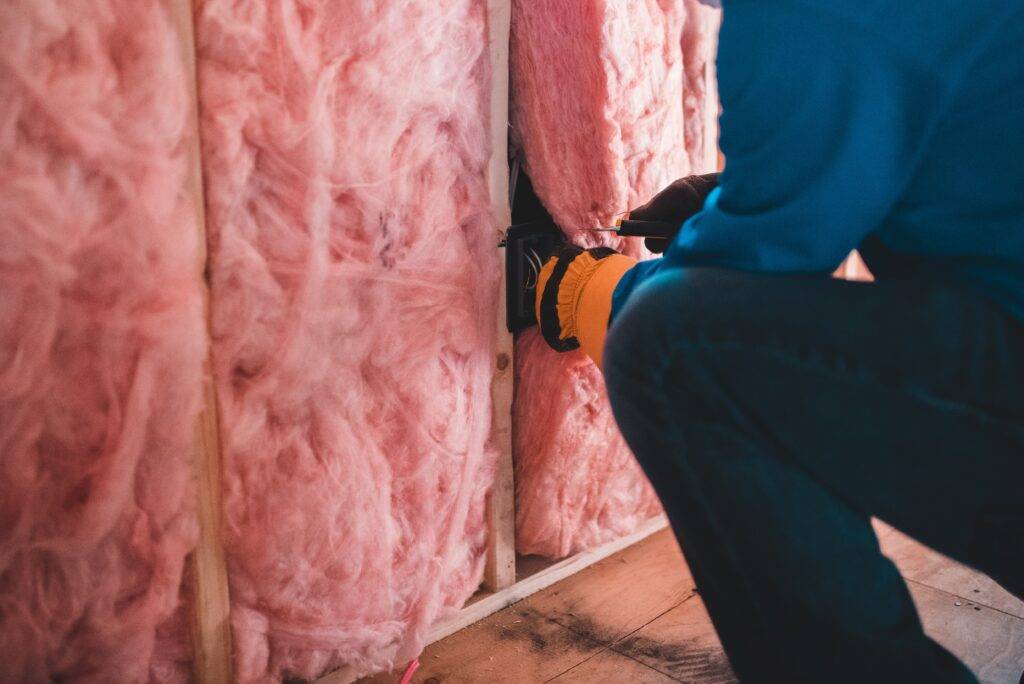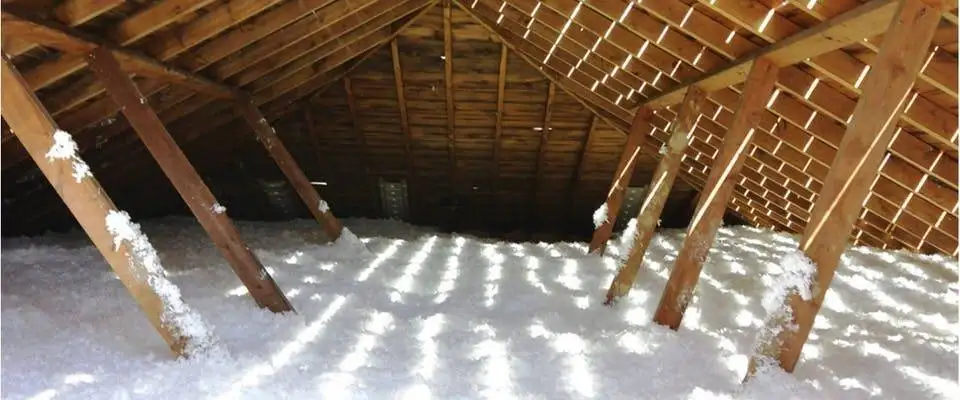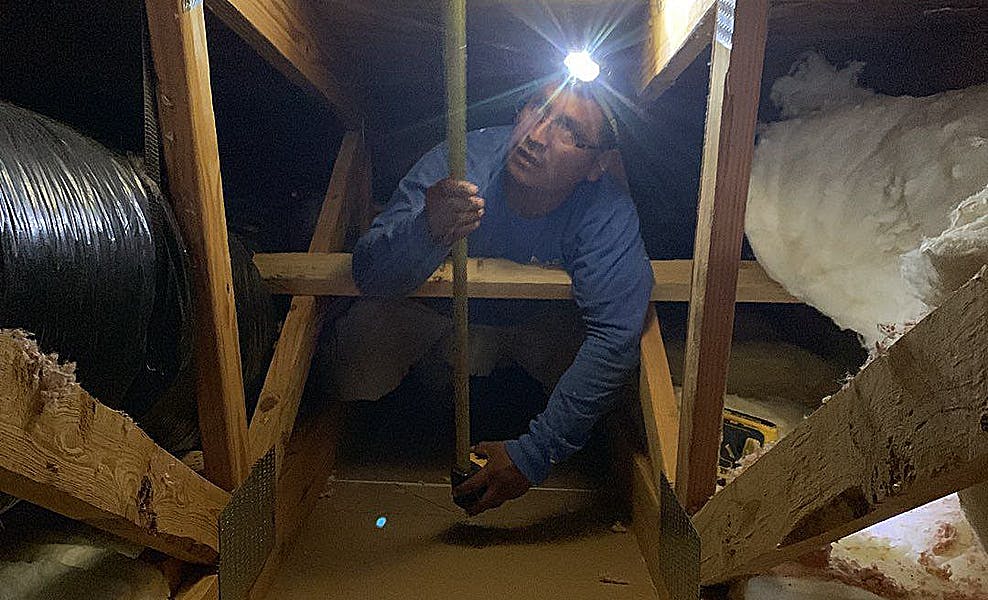Maintaining a well-insulated and properly ventilated attic is crucial for energy efficiency and the overall health of your home. Attic insulation and ventilation work together to regulate temperature, prevent moisture buildup, and extend the lifespan of your roof. Both are very important for protecting your home and roof, yet they are often overlooked!
In this article, we will explore the importance of attic insulation and ventilation, their benefits, and practical tips for homeowners to improve their attic’s insulation and ventilation systems.
What is Attic Insulation and Ventilation?
Attic insulation in your roof acts as a barrier, preventing heat transfer between your attic and your home’s living spaces. It keeps your house comfortable year-round and reduces energy consumption. Also, the more insulation you have, the less your home will be affected by the outside temperature!
Attic insulation materials are placed in your attic, often in between the rafters, right above your ceiling, or along the bottom of the roof decking. Common materials used for attic insulation include fiberglass, cellulose, spray foam, or battened insulation.
Attic ventilation, on the other hand, involves creating a balanced airflow system that allows hot air and moisture to escape while bringing in fresh air. Attic ventilation systems allow colder air in from the bottom of your roof, which pushes the hotter air out of the peak of your roof. This process helps regulate temperatures, reduces the risk of mold and mildew growth, and protects the structural integrity of your home. It also prevents ice dams in colder climates by maintaining a consistent attic temperature. Roofing material manufacturers also require proper attic ventilation in order to retain their warranties!
Vents and Insulation Help Regulate Temperature in Your Home
Insulation is the main contributor to regulating temperatures within your home. The recommended level of insulation is between R-38 to R-49, which will be about 13 to 18 inches of insulation in your attic. It’s also important to do some air sealing when increasing your insulation levels. Air sealing is where you specifically close off any gaps around light fixtures, fans, or vents in the ceiling that allow extra air through the ceiling into the attic.
The temperature in your home, mainly the top level, is also linked to the ventilation system on your roof. As damp air rises out of a home, it will go into the attic space and create condensation and eventually mold if your attic is not properly vented! If air is not permitted to flow through your attic space with adequate intake and exhaust for outside air, then heat will build up in your attic. This will affect not only your energy bills but also speed up the rate of aging for your roofing material.

What are the Benefits of Proper Insulation and Ventilation?
By working together, proper insulation and ventilation create an energy-efficient environment that minimizes the strain on your HVAC system. You will absolutely notice a difference in the temperature of your home and your energy bills after improving the insulation in your attic.
The ventilation system on your roof will also benefit the temperature in your home, along with prolonging the lifespan of your roof. We’ve seen shingles that were meant to last 50 years, completely fall apart 15 years in because of poor ventilation!
Improved Airflow in Your Attic
When the colder air comes in at the eaves, the warm air will be pushed out of the peak or exhaust vents. This enables the space to stay cooler and dry, getting all the moisture out of the attic and keeping it from forming condensation.
There are multiple types of airflow systems for an attic. To achieve optimal temperature regulation, it’s important to understand the different types of vents available. Ridge vents, gable vents, and soffit vents are commonly used in attics. Each type serves a specific purpose and requires proper placement and sizing to ensure effective ventilation.
Having vents on the gable sides of the house for air to come in one side and go out the other is one type. Another would be air that comes in at the eaves and exhausts through the peak or near it via a stationary ridge vent or an attic fan. It’s important to not mix the systems, but to choose one and stick with it! Consulting with a professional can help determine the best vent configuration for your attic.
Reducing Moisture That Causes Mold, Mildew, etc.
Possibly the most important reason for proper ventilation in your attic is to protect against mold. Moisture can accumulate in attics due to factors such as high humidity, condensation, and roof leaks. Without proper insulation and ventilation, this moisture can lead to the growth of mold, mildew, and rot, compromising both the structural integrity and indoor air quality of your home.
By allowing excess moisture to escape, proper ventilation prevents the buildup of condensation and reduces the risk of mold-related issues.
Better Regulated Temperatures within Your House
Increasing the R-value in your attic by adding more insulation will help get your home’s temperature under control. This means that your home will stay cooler in the summer and warmer in the winter, reducing the reliance on heating and cooling systems.

Ventilation Prolonging the Life of a Roof
A good ventilation system will maintain the quality of your home’s roofing material and help qualify you for the manufacturer’s warranty. When the roof has a proper ventilation system, it will lower the temperature of your attic and the roof itself. As a result, the roofing material is able to last longer. Excessive heat will cause shingles to blister or age so fast that it will begin to become brittle and breakdown!
Preventing Ice Dams in the Winter
Ice dams are typically formed along the eaves and gutters of a house because the snow from higher up on the roof melts, runs down and then freezes at the eaves. If the attic space is properly vented and insulated, it will help the entire surface of the roof to warm up and cool down at a more consistent rate, lowering your chances of ice dams in cold climates.
Planning Your Attic Upgrade: A Smart Approach
- Inspection & Assessment: A professional should inspect current insulation depth and condition, identify air leaks, assess venting type and blockages, and test for moisture issues.
- Air-Sealing Work: Before adding insulation, seal attic floor penetrations and attic-ceiling junctions.
- Install or Upgrade Ventilation System: If needed, upgrade soffit intake, ridge exhaust, or other venting to create balanced airflow.
- Add Insulation: Install to meet current R-value recommendations, taking care not to obstruct vents or compress insulation.
- Final Verification & Maintenance Plan: Ensure vents remain clear, insulation is undisturbed, and check the attic annually for signs of condensation or airflow disruption.
Why Choose Our Team for Attic Insulation & Ventilation
- We inspect not only insulation depth and materials but also vent placement, airflow paths, and moisture indicators.
- We understand the interplay between parts of your roof system, attic ventilation, and insulation—ensuring one upgrade doesn’t create unintended issues for another.
- We coordinate insulation upgrades and ventilation repairs as integrated projects, reducing redundant visits and improving overall performance.
When you’re prepared to invest in your attic’s long-term performance, reach out for a full attic evaluation.
How Homeowners Can Improve Their Attic Ventilation and Insulation
Consulting a professional to assess your attic’s ventilation needs is essential to the overall health of your home. They can provide expert recommendations and install new vent systems that suit your attic’s size, layout, and current climate control issues.
Installing New Vent Systems
Most homes will already have roof vents in place. However, over the years, building codes have improved and recommendations have changed. So, it’s important to reevaluate the type of system you have. Remember, you don’t want to mix different venting systems, instead, you want to optimize for a single, well-performing system.
The best attic ventilation system will have air coming in at the eaves and leaving through a ridge vent. If this is the system you have in place, but you install a random gable vent or attic fan, it could actually have a negative effect on your home! If you mix ventilation systems it will create spaces in your attic where the air isn’t moving, which can potentially result in mold or damaged roof decking.
Intake and Exhaust Vents
A well-planned configuration will promote efficient airflow and prevent issues such as moisture buildup and temperature imbalances. Intake vents are typically at the soffit, but in cases where this is not possible, you can install inflow vents at the bottom of the roof, right under the roofing material. The exhaust vents also come in a variety of options depending on your home’s needs.
Attic Fan Ventilation
In some cases, natural ventilation may not be sufficient, especially in areas with limited airflow. Attic fans can be a great alternative source for venting your attic because it forces the air to move. You are even able to have solar powered fans installed as opposed to traditional electric ones!

Replacing Your Attic's Insulation
Proper installation of insulation is crucial to maximize its effectiveness. Ensuring proper air sealing, avoiding compressed insulation, and maintaining the recommended R-value for your climate are essential considerations.
Start with air sealing, closing any gaps around light fixtures, fans, or any other objects that stick through the ceiling into the attic floor. Next, you’ll need to make sure to install baffles wherever you have eave vents, that way your attic venting system can still work. Then, you can either lay down batten insulation or use blown-in insulation, which is much easier. Lastly, don’t forget to have specific insulation installed around the area of the attic door!
Schedule a Home Inspection with a Professional
If you’re not sure about the ventilation in your attic and you experience extreme temperatures in the upper level of your home, you should definitely have your attic inspected by a trusted professional.
RoofPRO is a Trusted Contractor for Attic Insulation and Ventilation
With the assistance of professionals like RoofPRO, you can optimize your attic insulation and ventilation systems, ensuring long-term efficiency and a healthier home!
When RoofPRO’s team inspects the ventilation and insulation of your home, we go into the attic and make sure all the vents are open and working. We’ll also check the attic fans to make sure they are still functioning and that all the eave vents have baffles. Next, we’ll measure the depth of insulation and give you a full report of our recommendations for maintaining the quality of your roof and attic space.
Invest in your home’s attic systems and enjoy the benefits for years to come by scheduling an attic insulation and ventilation inspection with RoofPRO today.


Author Bio
Tim Taylor – Owner & Founder of RoofPRO
Tim Taylor began his roofing career in 2003 and founded RoofPRO in 2004 with a mission to fix the poor workmanship that often causes roof leaks. With over 20 years of hands-on experience, he’s earned elite credentials like CertainTeed’s ShingleMaster Wizard certification, HAAG inspection certifications, and OSHA safety training. His expertise in leak repair, flashing repair, and post-storm restoration has made RoofPRO one of Maryland’s most trusted roofing companies. Tim continues to lead with the same principle that built his reputation—roof it right the first time

